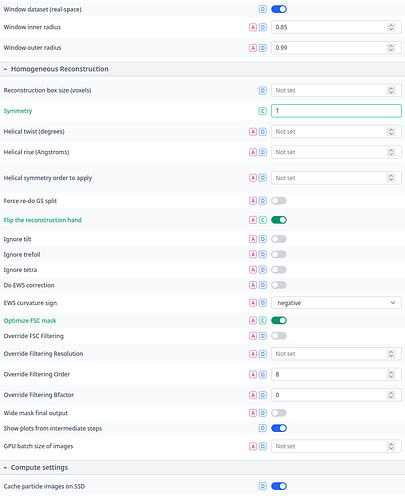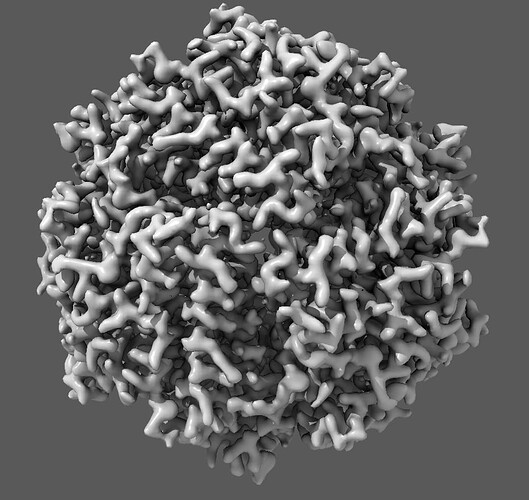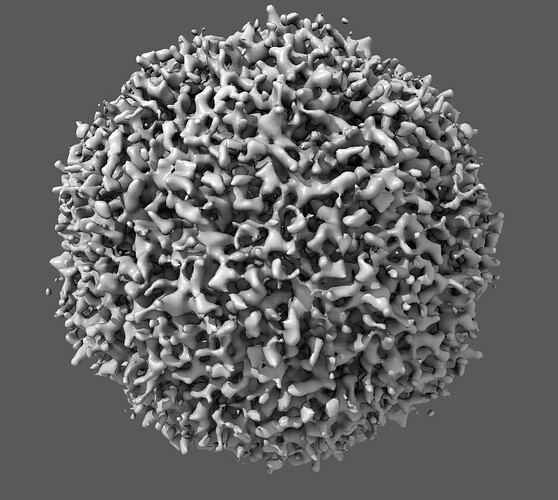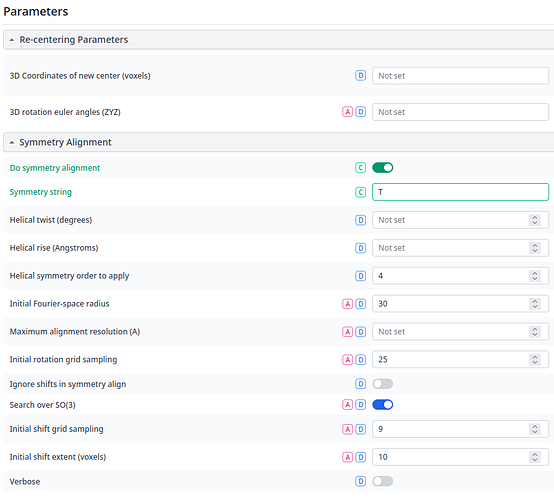I have been encountering a bug, or have some sort of blind spot to a problem that I keep running into. I have a tetrahedral dodecameric structure that goes to ~2 Å. The entire workflow was done in CryoSPARC the traditional way: pick particles, 2D, Ab initio, homogenous refinement, download and inspect map.
At 2 Å, there really is no ambiguity that I can tell. The structure seems, to me, quite clearly to have inverted handedness. Running the CryoSPARC job to flip the hand, or flipping it in ChimeraX (volume #n flip) makes a map that fits the model, has right-handed ɑ-helices, etc.
The strange behavior is when I try to run phenix.map_symmetry to get a NCS spec file. On the non-flipped map, this results:
SCORE CC OPERATORS SYMMETRY
3.32 0.97 12 T (c)
1.69 0.98 3 C3
0.00 0.27 28 D14 (a)
0.00 0.27 28 D14 (b)
0.00 0.55 6 D3 (b)
0.00 0.28 60 I (b)
0.00 0.23 60 I (d)
0.00 0.19 60 I (f)
0.00 0.22 60 I (a)
0.00 0.20 60 I (c)
0.00 0.25 60 I (e)
0.00 0.15 24 O (a)
0.00 0.17 24 O (b)
0.00 0.28 12 T (a)
0.00 0.31 12 T (b)
However, after flipping in either CryoSPARC, or ChimeraX, running the same command on the flipped map results in:
SCORE CC OPERATORS SYMMETRY
1.69 0.98 3 C3
0.00 0.24 26 D13 (a)
0.00 0.26 26 D13 (b)
0.00 0.27 28 D14 (a)
0.00 0.27 28 D14 (b)
0.00 0.18 60 I (b)
0.00 0.21 60 I (d)
0.00 0.25 60 I (f)
0.00 0.15 60 I (a)
0.00 0.28 60 I (c)
0.00 0.18 60 I (e)
0.00 0.18 24 O (a)
0.00 0.13 24 O (b)
0.00 0.59 12 T (a)
0.00 0.28 12 T (b)
0.00 0.42 12 T (c)
This is very odd. Flipped is clearly correct, the structure is clearly tetrahedral, and yet Phenix only finds C3? I was ready to fire off an email to the Phenix mailing list, asking them what is going on and if I found a bug in their software, but then I realized something. I ran a 3D volume alignment job in CryoSPARC, on just the flipped map, asking it to please align to the T symmetry axes. That alignment job spit out both a translation and rotation matrix it needed to get the volume aligned:
Aligning with T point group symmetry enforced
Aligning rotation matrix:
[[-0.5004003 0.29090047 0.8154609 ]
[-0.86579347 -0.16691318 -0.47174335]
[-0.0011192 -0.9420812 0.33538303]]
Aligning shift:
[ 0.0390625 -0.0390625 0.9765625]
At least to me that doesn’t make any sense. Why would flipping the map cause it to move away from the symmetry axes? And why only the two-fold axes?
If I take that flipped, but re-aligned map and feed it into phenix.map_symmetry again, I get back the expected output:
SCORE CC OPERATORS SYMMETRY
3.28 0.96 12 T (c)
1.68 0.97 3 C3
0.00 0.28 28 D14 (a)
0.00 0.28 28 D14 (b)
0.00 0.58 6 D3 (b)
0.00 0.19 60 I (b)
0.00 0.21 60 I (d)
0.00 0.31 60 I (f)
0.00 0.24 60 I (a)
0.00 0.22 60 I (c)
0.00 0.30 60 I (e)
0.00 0.29 24 O (a)
0.00 0.27 24 O (b)
0.00 0.53 12 T (a)
0.00 0.16 12 T (b)
OK, well I sort of know why it wasn’t working, and now I want to use phenix.voyager.em_placement in ChimeraX to dock my model in, and for that I need half maps. I thought about running the Volume Tools job to flip the half maps, but I figured it’d be cleaner to do a Homogenous Reconstruction with the map hand flipped, instead. Here are the settings I chose for that reconstruction:
I connected only a previous best, non-flipped (so wrong hand) refinement volume, and particles. I did not connect a mask. Unfortunately, the reconstruction particle has drastically declined in quality.
Here’s the volume I put it (unflipped):
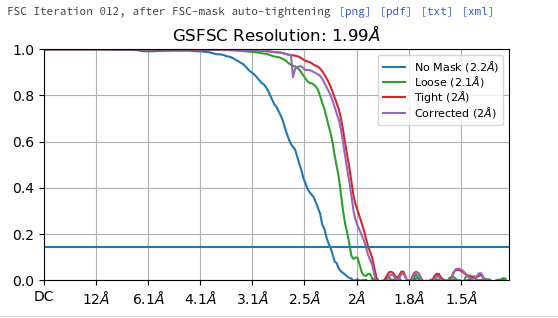
Here’s the volume manually flipped, with the model coarsely docked, that I believe shows the flipped version is the proper hand:
Here is the Homogenous Reconstruction output that I told to reconstruct with a flipped hand:

I’m very confused on two things:
- Why does flipping the hand move the volume slightly off the rotation axis?
- Why does reconstruction the volume with a flipped hand dramatically alter map quality (even though the FSC goes to near the same resolution)?
Is there some part of this I’m not considering?
